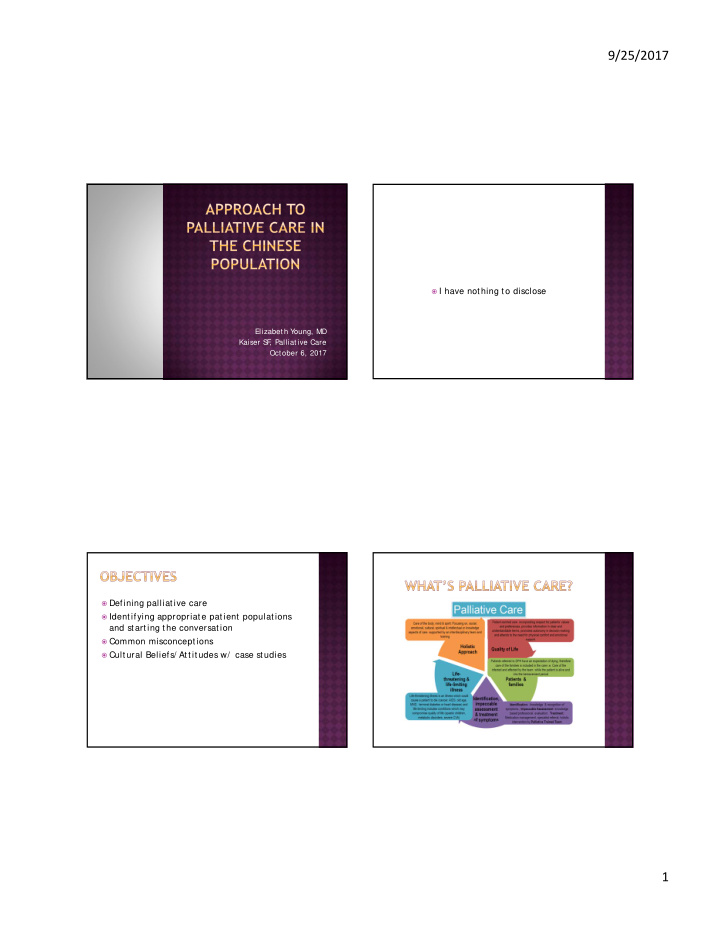



9/25/2017 I have nothing to disclose Elizabet h Y oung, MD Kaiser S F , Palliative Care October 6, 2017 Defining palliat ive care Identifying appropriate patient populations and st art ing t he conversat ion Common misconceptions Cultural Beliefs/ Attitudes w/ case studies 1
9/25/2017 Metastatic cancer Palliat ive Care (PC) = Hospice Care Chronic/ Degenerat ive Disease w/ mult iple PC = you are dying hospitalizations in past year PC = bad news t hat no ot her provider has Frail shared yet PC = “ giving up” or no t reat ment “ SURPRISE QUESTION” - Would you be PC team will put patient on a morphine drip surprised if t his pat ient died in t he next unt il t hey die year? Brief t he int erpret er, set expect at ions, cultural guide Many t erms can be t ranslat ed a number of different ways, some wit h very negat ive connotation For medical update: Use short phrases, simple language, “ teach- back” key element s 2
9/25/2017 Doctors as Authority Figure “ Y es Doctor” complex Ext ra layer of support t o care for t hose wit h Identifying a healthcare proxy may seem difficult serious/ life-limiting illness Death may be a taboo topic 1) Symptom management : Physical and Emotional Filial Piety “ Hsiao” 2) Communication: Medical team, Patient Children have the duty to protect their parent s’ and Family health, safety, and well-being 3) Planning: Decision Making, Preparedness, Children may advocat e for Goals of Care, Advanced Directive, POLST aggressive treatment The FOCUS is on LIFE , how to live well, how t o make every day a bet t er day 70y/ o male met nasopharyngeal ca -> brain, on home hospice Familial hierarchy Admitted for dyspnea, F , AMS -> bacteremic, Family based vs. personal autonomy severe sepsis Speaking to wrong family member Son told primary team over t he phone, “ Do Y ounger (more “ westernized” ) generation everyt hing!” Gender-determined roles Family meet ing wit h int erpret er, wife, son, and daught er Wife acknowledged t hat her husband was dying and asked to stop aggressive treatment 3
9/25/2017 41y/ o male w/ metastatic lung cancer Escalating pain that was difficult to control, Limited emotional expressiveness; stoicism asked for physician assisted suicide Downplay the severity of symptoms Parent s refused to talk about EOL May not acknowledge depression or Admitted to hospital at the end of his life for anxiety comfort care Cont ribute to total body pain Pragmat ic, hard t o have generalized/ broad GOC discussion Be specific in achievable goals; consider finances, home support , medicat ion management Bell CL, Kuriya M, Fischberg D. Hospice Referrals and Code St at us: Out comes of Inpat ient Palliat ive Care Consult at ions Among Asian Americans and Pacific Islanders wit h Cancer. J Pain Sympt om Manage 2011; 42(4): 557-564 Fernandes R, Braun KL, Ozawa J, et al. Home-Based Palliat ive Care Services for Underserved Populat ions. J Palliat Med 2010; 13(4): 413-419 Mondia S, Hichenberg S, Kerr E, et al. The Impact of Asian American Value Syst ems on Palliat ive Care: Illust rat ive Cases From t he Family-Focused Grief Therapy t rial. Am J Hosp Palliat Med 2012; 29(6): 443-448 Palliative Care = I’ m worried about you and I Schenker Y , Smit h AK, Arnold RM, Fernandez A. ‘‘ Her Husband Doesn’ t Speak Much English’’ : Conduct ing a Family Meet ing wit h an Int erpret er. J Palliat Med 2012; would like to give you extra help 15(4): 494-498 Wang J, Kearney JA. The experience of Chinese American parent s of children wit h life-limit ing illness: a comprehensive review. Int l J Palliat Nursing 2013; 19(7): 347- 354 Chinese-American Out reach Guide. Available online at www.caringinfo.org under ‘ communit y’ www.caccc-usa.org ht t p:/ / coalitionccc.org 4
Recommend
More recommend